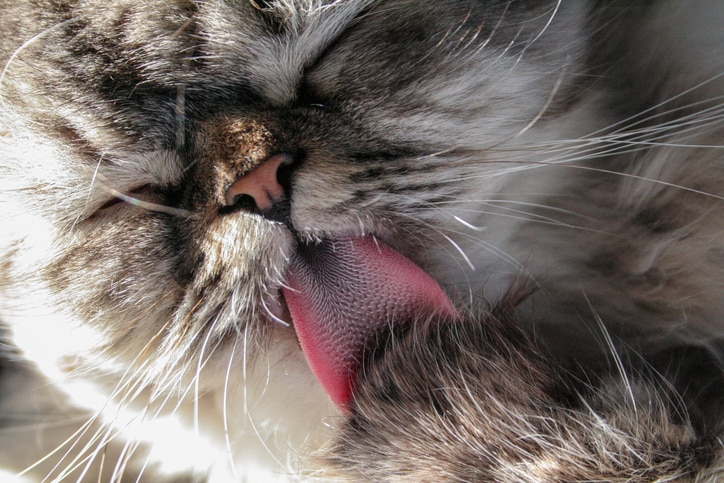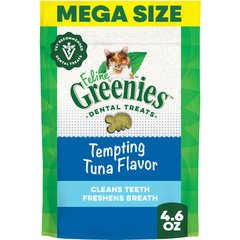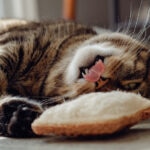Why Are Cats’ Tongues So Rough?

Photo by Volodymyr Kobozov/iStock/Getty Images Plus
If you’ve ever been licked by a cat, you know their tongues feel surprisingly scratchy, like sandpaper. But that rough texture is part of the reason cats are such skilled groomers, hunters, and communicators.
Here’s the science behind cats’ tongues and why they’re essential for our feline besties.
Key Takeaways:
- A cat’s tongue is covered in papillae, or pointy, curved cones made of keratin.
- The texture of a cat’s tongue helps them groom, drink, eat, and do other key cat things.
- It’s usually harmless when your cat licks you, but buy them lick mats if it gets to be excessive.
What’s So Special About a Cat’s Tongue?
At first glance, a cat’s tongue might not seem that different from a dog’s tongue (or even a human’s). But examine a cat tongue up close, and you’ll see what look like tiny spikes.

Photo by petesphotography/iStock/Getty Images Plus
“A good portion of the top side of a cat’s tongue is covered with papillae—pointy, curved cones that are made of keratin, the same material that makes up human fingernails,” says Jennifer Coates, DVM, a veterinarian in Fort Collins, Colorado. “This is why a cat’s tongue is so scratchy when they lick you.”
But papillae aren’t exclusive to cats. In fact, “all mammals have different types of papillae in different parts of their tongues,” says Krista Sirois, DVM, an associate veterinarian with Lap of Love in Austin, Texas.
What sets cats apart, she explains, is the type they have: filiform papillae. “You can think of the filiform papillae as ‘spines’ facing toward the back of the mouth,” she says.

Photo by Todorean Gabriel/iStock/Getty Images Plus
What else makes a cat’s tongue stand out from other mammals? Their minimal taste buds.
“Cats have significantly fewer taste buds than other mammals. Dogs have more than three times the number that cats have, and human tongues have 19 times more taste buds than a cat’s,” says Dr. Sirois.
So, the next time your cat turns their nose up at your dinner selection, don’t blame them—blame their tongues.
Why Is a Cat’s Tongue So Rough?
That scratchy texture? It’s not random. It turns out that a cat’s tongue serves some important purposes.
It Helps Them Groom
Maybe it’s Maybelline … maybe it’s … evolution? Cats spend 30% to 50% of their day grooming themselves, and papillae assist them with this task. “The papillae can reach all the way down to a cat’s skin, allowing them to thoroughly ‘brush out’ their coat,” says Dr. Coates.
But papillae do more than detangle fur. “They remove debris, loose fur, dust, and other particles from the coat,” says Dr. Sirois. “They also help evenly distribute the body’s oils across the cat’s coat, keeping it smooth and shiny,” she says.
It Helps Them Drink
Have you ever noticed that dogs splash water all over the place when they drink, while cats seem to make less of a mess? It’s not because they have better manners than their canine counterparts; it’s because cats’ tongues allow for more efficient drinking.
“Both dogs and cats lack the ability of suction, but they have developed different ways of working around this issue,” says Dr. Sirois.
“The cat tongue extends out and then curls backward underneath. Rather than scooping water like the tip of a dog’s tongue does, the cat tongue just touches the surface of the water and then flicks back in,” she explains. “Water adheres to the top of the tongue and is pulled into the mouth, without the tongue breaking the water’s surface.”
It Helps Them Eat
Papillae are also incredibly useful eating utensils, according to Dr. Sirois. “The papillae help cats wipe clean the bones of prey when eating and also move food toward the back of the mouth,” she says.
Even if your cat’s idea of “hunting” is finding an old treat behind the couch, their tongues ensure they enjoy every last crumb.
It Helps Them Cool Down
Cats’ tongues also double as temperature control. Dr. Sirois says grooming regulates body temperature and improves circulation to stimulated areas. Basically, it’s like having built-in air conditioning.
“Papillae are hollow and suck up saliva that is then deposited in the cat’s fur during grooming,” says Dr. Coates. “When the saliva evaporates, it helps keep the cat cool.”
It Helps Them Communicate and Socialize
Cats use licking to bond with other cats and human family members. But they also use their tongues to understand the world around them, especially when it comes to smells and pheromones.
“Cats are one of a variety of species that exhibit the flehmen response, where they open their mouths, stick out their tongues slightly, and take pheromones into their vomeronasal organ,” says Dr. Sirois.
This behavior lets cats process interesting scents, like an area where an unfamiliar animal has been or your socks after a long workout.
Why a Cat’s Tongue Can Also Cause Trouble
While cats’ tongues are impressive tools, they can occasionally lead to some challenges for felines and their pet parents.
Accidental Ingestion of Yarn or String
Cats love playing with yarn and string, but these items are particularly dangerous for them, says Dr. Coates.
“If a cat is playing with string or yarn and swallows it, a loop can become wrapped around the base of the tongue while the rest travels down the digestive tract,” she says. “The intestines can bunch up along the string, leading to cuts in the intestinal wall, infection, and the need for surgery.”
If your cat ingests any length of yarn or string, contact your veterinarian immediately.
Alerting You to Bigger Health Issues
The occasional “blep” (when your cat’s tongue peeks out while they’re relaxed) is harmless—and let’s be honest—pretty cute. But when it starts happening often, or alongside other symptoms, it could be a sign your cat is sick or has a medical condition.
“A healthy cat tongue is a lightish pink color with white backward-facing spines. It should not have any disruptions to the surface, such as abrasions, bleeding, or blisters,” says Dr. Sirois.
If your cat’s tongue suddenly starts hanging out all the time, or they seem to struggle to keep it in their mouth, don’t ignore it. Dr. Sirois says trouble chewing, excessive drooling, or dropping food can all point to an underlying problem that warrants a vet visit.
Not Everyone Benefits from a Cat’s Lick
For the most part, a cat licking you is harmless. That said, there are a few situations where you should exercise caution.
“A cat licking you carries a low level of risk, primarily related to the bacteria a cat’s mouth carries,” says Dr Sirois. “For this reason, those with thin skin, open wounds, or a compromised immune system would be at greater risk for infection from a cat licking them. Those with an allergy to cat saliva should also avoid being licked.”
If your cat tends to escalate from licking to biting or licks very intensely, Dr. Sirois recommends redirecting this behavior. Appropriate outlets include lick mats, silvervine sticks, dental treats and chews, and kick toys that simulate prey for hunting.
Recommended Products
FAQs About Cats’ Tongues
Q: Are cats the only animals with rough tongues?
A: Nope! Domestic cats share this trait with big cats, such as lions, tigers, bobcats, snow leopards, and cougars. Other animals, like giraffes and camels, have rough tongues with thick papillae that protect them from thorns when chomping leaves.
Q: Why don’t dogs have rough tongues like cats?
A: It’s all about evolution. Dogs didn’t need rough tongues like cats. Cats hunt alone and are small enough to be hunted themselves. Grooming helps them stay clean and scent-free, so their tongues evolved to assist them with this task. Dogs descended from pack-hunting wolves. They didn’t need to hide their scent or groom as obsessively, so they have standard (yet still functional and cute) tongues.
Q: Can a cat’s tongue hurt you?
A: In most situations, the answer is no, says Dr. Coates. “A cat’s tongue can’t cut healthy human skin. However, prolonged licking could lead to abrasions or infections, particularly if a person’s skin is delicate or already damaged,” she says.






